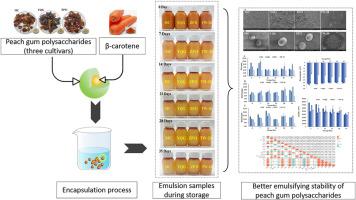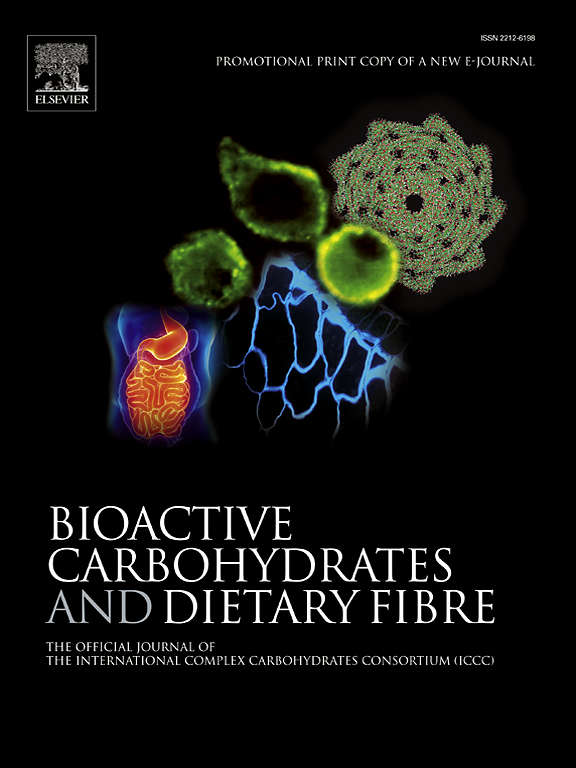探索桃胶多糖在β-胡萝卜素乳剂储存过程中的封装潜力
IF 3.6
引用次数: 0
摘要
水包油(O/W)乳剂已成为封装β-胡萝卜素的一种可行方法。为了获得稳定的乳液体系,开发潜伏乳化剂至关重要。本研究收集了三种水蜜桃栽培品种(Mixture cultivar (MC)、Zhonghpan 11# (ZP11)和Yingqing (YQG)),提取桃胶多糖(PGP)用于封装β-胡萝卜素,而无需额外的乳化剂。研究旨在调查乳液在储存期间的理化稳定性(包括粒度、ZETA电位、浑浊度、颜色和β-胡萝卜素(RR)的保留率)。研究结果表明,ZP11 乳液的乳化效率(EE)最高,为 89.08%,且颜色更鲜艳。贮藏 35 天后,YQG 乳液表现出更好的乳液稳定性,其 zeta 电位(>35 mV,负值)、β-胡萝卜素 RR(43.44%)和半衰期(t1/2,32.31d)在三个栽培品种中最高。相关分析表明,PGP 的分子量(Mw)、多分散系数(Mw/Mn)和阿拉伯糖(Ara)会影响其乳化能力和 β-胡萝卜素乳液的稳定性。这些信息对 PGP 作为乳化剂和稳定剂的巨大潜力具有重要意义,为设计适当的给药系统提供了可能。本文章由计算机程序翻译,如有差异,请以英文原文为准。

Exploring the potential of peach gum polysaccharides in β-carotene emulsions encapsulation during storage
Oil-in-water (O/W) emulsions have emerged as a viable method for encapsulating β-carotene. To achieve stable emulsion systems, the development of latent emulsifiers is essential. This study collected three peach cultivars (Mixture cultivar (MC), Zhonghpan 11# (ZP11), and Yingqing (YQG)) to extract peach gum polysaccharides (PGP) for the encapsulation of β-carotene without the need for additional emulsifiers. The research aimed to investigate the emulsions' physicochemical stability (including particle size, zeta potential, turbidity, color, and retention rate of β-carotene (RR)) during storage. The findings revealed that the ZP11 emulsion exhibited the highest emulsion efficiency (EE) at 89.08% and displayed a more vibrant color. After 35 days of storage, YQG emulsion exhibited better emulsion stability with the highest zeta-potential (>35 mV, negative), RR of β-carotene (43.44%), and longest half-life period (t1/2, 32.31d) among three cultivars. Correlation analysis showed that molecular weight (Mw), polydispersity coefficient (Mw/Mn), and arabinose (Ara) of PGP would have an influence on its emulsifying capacity and stability of β-carotene emulsion. The information was significant for PGP of great potential as an emulsifier and stabilizer to provide possibility regarding designing a proper delivery system.
求助全文
通过发布文献求助,成功后即可免费获取论文全文。
去求助
来源期刊

Bioactive Carbohydrates and Dietary Fibre
Agricultural and Biological Sciences-Food Science
CiteScore
6.00
自引率
0.00%
发文量
38
期刊介绍:
 求助内容:
求助内容: 应助结果提醒方式:
应助结果提醒方式:


